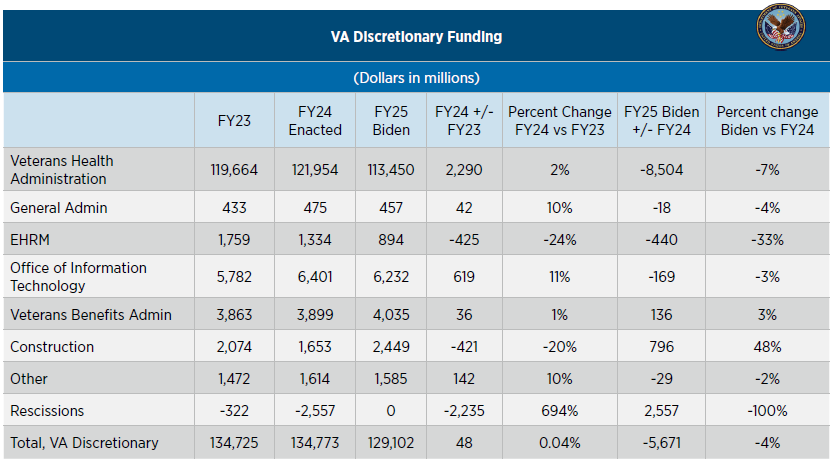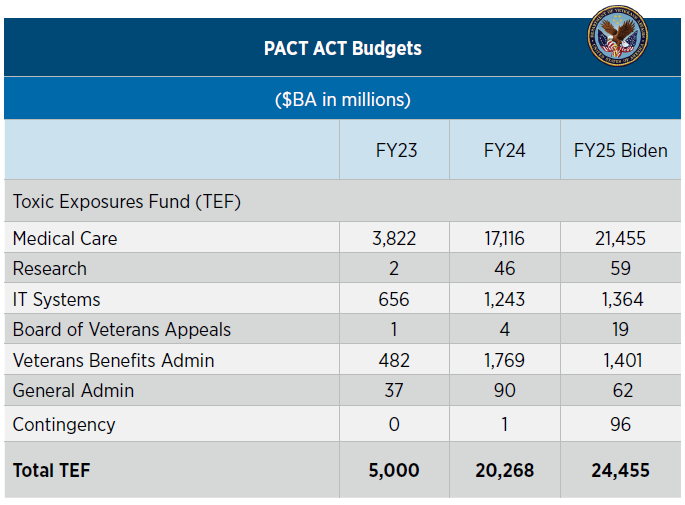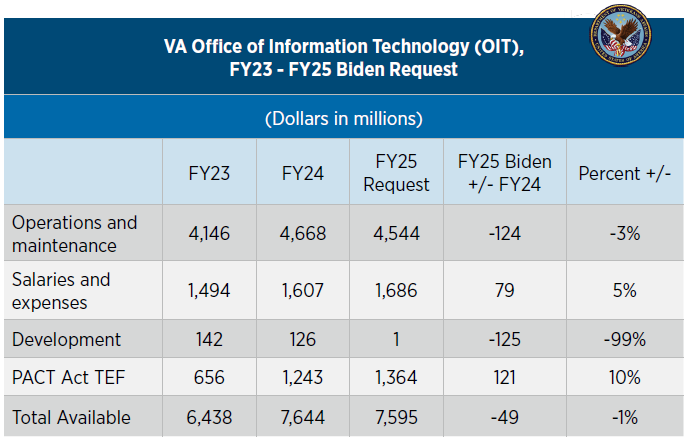

Last week, Congress passed six FY24 spending bills, including the Military Construction and Veterans Affairs bill. Only two days after the President signed the FY24 VA spending bill on March 9, he sent his administration’s FY25 budget proposal to Congress. Overall, the Biden FY25 budget for VA is $369 billion, which includes both mandatory and discretionary funding and is 10% over the FY24 level. However, mandatory funding is rising while discretionary funding is declining. VA’s mandatory funding request is $265 billion, a 22% increase over FY24. It includes compensation and pension funds, education benefits, and PACT Act funding.
Discretionary funding for medical services, IT, research, and administration, is slated to decrease 4% in FY25. This is the first Biden budget developed under the terms of the Fiscal Responsibility Act (FRA) of 2023, a bipartisan compromise that set “top level” numbers for FY24 and FY25 discretionary spending. Efforts by the Biden Administration to move VA spending outside the discretionary caps were not successful. The downward pressure on discretionary spending affects VA and will be a challenge to manage, although the Department has funding options and flexibility that other agencies do not. The bottom line is that the final FY24 discretionary total for VA is $137.8 billion, essentially flat from the FY23 level of $137.7 billion. The Biden FY25 budget request is below the FY24 level, cutting $5.7 billion, or 4% from FY24 discretionary totals, as outlined in Chart I.


Chart I. Source: House and Senate Appropriations committees, VA, OMB, FBIQ. VA Discretionary Funding, FY23-FY25 Requested. Totals may not add up due to rounding. Does not include Medical Collections or Non-recurring Transformation Fund amounts.
FY24 ROUNDUP
VA’s FY24 enacted funding levels are largely in line with the Biden FY24 VA budget request, with a few exceptions to balance the books. The FY24 Biden request was $3 billion more than the final appropriation provided; however, the budget request was made in March 2023 before the FRA was enacted. Cuts across government were necessary to conform with lower FRA levels. Congress trimmed $2.6 billion by rescinding prior year funding that VA had not expended, including medical services, IT, Electronic Health Record Modernization (EHRM) and various administrative funds; in particular, Congress rescinded $460 million from EHRM balances and cut $529 million from the Biden FY24 budget request for EHRM. In final FY24 action, Congress exceeded the Biden FY24 VA budget only for Medical and Prosthetic Research ($943 million, +$5 million over Biden request), Medical Facilities ($9.5 billion, +$149 million), Construction (+$92 million), and Grants for State Facilities (+$7 million).
PACT ACT
As noted, VA has additional funding sources and budget flexibility that will be key to meeting continued needs of veterans and their families, and the necessary IT, workforce, and infrastructure. Most notably, the PACT Act of 2022 provides billions in new funding to cover medical and associated needs of veterans with toxic exposure, such as medical conditions caused by proximity to burn pits. In addition to compensation payments and health care services, the PACT Act directs funding for the mission-critical backbone to deliver those services—information technology, staff, and facilities. The FRA included $20.3 billion in FY24 funds and $24.5 billion in FY25 funds for the PACT Act Cost of War Toxic Exposures Fund (TEF), as seen in Chart II. Those funds, available for five years, are slated for medical care, research, IT, and administrative services. VA also has a smaller non-recurring expenses transformation fund that can be used for IT and facilities, which will bring $676 million in FY24. With these additions, VA states that it can meet expected veteran needs with the FY24 enacted budget.


Chart II: VA PACT Act Toxic Exposure Funding Profile, FY23-FY25. Source: VA FY25 Budget. Totals may not add due to rounding.
FY25 HIGHLIGHTS
The FY25 Biden budget request cuts VA discretionary spending $5.7 billion below the enacted FY24 level, a 4% cut. In press releases and budget documents, VA states that the FY25 budget cuts VA by $8.9 billion, or a 6% cut from FY24 levels. However, VA based the comparison on estimated FY24 numbers because their FY25 budget documents were completed before Congress finalized FY24 in P.L. 118-42. Actual FY24 numbers were lower than VA predicted so the gap between FY24 and FY25 was smaller. Nonetheless, a 4% cut for Veterans Affairs has not been proposed by a President in decades. VA needed to trim its number so the overall federal budget would be in line with the FRA top-line limits for non-defense funding.
What does a 4% FY25 funding cut mean for VA? As evidenced in FY24 Appropriations, IT and EHRM may bear the brunt of the reductions. Medical services will be boosted by new FY25 PACT Act/TEF funds, plus TEF carryover from FY24, estimated at $3.6 billion. VA also projects that at least $6.8 billion in regular discretionary dollars will not be expended in FY24, allowing excess medical funds (which are available for two years) to be used through FY25. Medical services funding, with these carryover funds, won’t fall below FY24 levels. VA’s accounts with less flexibility will face more of a challenge.
EHRM “RESET”
Final FY24 appropriations enacted a reduction of nearly $1 billion to the EHRM program—a rescission of $460 million in prior year funds and a cut of $529 million from Biden’s FY24 EHRM budget. Both actions are a response to faltering EHRM deployments and another “reset.” As in prior years, Congress emphasized oversight, requiring reports on expenditures, schedules, and implementation, and held back 25% of EHRM funding until conditions are met by the VA Secretary. The EHRM program’s FY25 budget request is $894 million, which is $440 million below the FY24 enacted level. The request includes $375 million for the EHR contract (down from $1.2 billion), $191 million for infrastructure, and $328 million for program management. Most significantly, VA states “there are no deployment funds in this request.” The “reset” mode means EHRM will support just six sites with an enterprise integration, training, and sustainment focus. No new sites will be assessed or added in FY25.
RECASTING IT PRIORITIES
VA’s FY25 Information Systems dashboard of CIO priorities show a huge hit to IT modernization while “Digital-First CSX“ is the top priority at $3.5 billion (half of the IT budget), increasing $449 million over FY24. IT modernization drops 81% from $1.0 billion in FY24 to $192 million. Other priorities are cybersecurity, increasing by $118 million to $670 million in FY25; the IT workforce, which will get a $82 million boost from $1.62 billion to $1.7 billion; and “data as a strategic asset,” slated for a $17 million increase from $120 million in FY24 to $137 million.
Overall, VA’s proposed FY25 IT budget includes a $49 million, or 1% cut, to OIT from the FY24 enacted level. As show in Chart III, the $7.6 billion total includes $4.5 billion for Operations and Maintenance (O&M), $1.7 billion for personnel, $1.3 billion from the PACT Act/TEF and $1 million for development.
OIT has steadily cut development funding, as VA fully transitions to a “buy not build” model, and with just $1 million in the budget request, system development within VA is over. O&M is proposed for a $124 million cut and TEF-funded programs a $121 million increase from FY24. OIT states that, within the amounts requested, existing and legacy systems, including supply chain management, will increase $725 million; Zero Trust Architecture will increase $49 million, and artificial intelligence would get a $4 million increase. VA also states that it will maintain the Infrastructure Readiness Program, as a priority. Further details that explain the OIT FY25 budget request are still being analyzed by FBIQ.
With the PACT Act TEF funds, OIT intends invest $286 million for claims processing, $68 million for benefits payments, $51 million for benefits appeals, and $346 million for an “improved veterans experience.” TEF funds are available for five years.
Most of VA’s IT funding is available for one year, with just 3-5% of overall funds allowed to be carried over into the following fiscal year. As with other agencies, the more than six-month delay in federal appropriations will have a major effect on VA IT acquisitions, pushing awards into late Q3 and Q4.


Chart III: OIT Discretionary and TEF Funding, FY23-FY25 Request. Source: FY23 and FY24 Appropriations Acts and VA FY25 Budget Request.
FY25: TIME, TEMPERATURE AND PRESSURE
Although we expect every agency to operate under CRs from October until after the November elections, VA’s unique mix of funding sources, advance appropriations, budget flexibility, and authority to carry over substantial unused funds puts it in the best position of all federal Departments to deal with uncertainty and delays. As we saw in FY24, VA funding priorities are likely to do well in House and Senate appropriations action with few changes to the President’s FY25 budget request. Oversight of EHRM and other large IT efforts, such as Supply Chain Management, will be priorities for members of Congress, and as always, VA will enjoy strong support for quality health care for veterans and accurate and timely benefits processing. We anticipate a repeat of the dueling FY24 House and Senate approaches to spending bills. Both will probably be within the FRA top-line spending levels, leaving little room for growth over FY24. The House majority is likely to include partisan policy riders that the Senate generally avoided in its bills. Expect contentious budget hearings and fiery debates, as the heat of a Presidential election year and the challenge of limited time on the House and Senate calendars build pressure for legislators to deliver for voters.